Servicios Personalizados
Articulo
Indicadores
Links relacionados
-
 Citado por Google
Citado por Google -
 Similares en Google
Similares en Google
Compartir
South African Journal of Science
versión On-line ISSN 1996-7489
versión impresa ISSN 0038-2353
S. Afr. j. sci. vol.107 no.3-4 Pretoria mar./abr. 2011
http://dx.doi.org/10.4102/sajs.v107i3/4.389
RESEARCH ARTICLE
Ultrasonic wave effects on the diameter of TiO2 nanoparticles
Hossain Milani MoghaddamI,II,III; Shahruz NasirianI,II,IV
IPhysics Department, Mazandaran University, Babolsar, Iran
IIMolecular Electronics Lab, Physics Department, Mazandaran University, Babolsar, Iran
IIINano and Biotechnology Group, Faculty of Basic Sciences, Mazandaran University, Babolsar, Iran
IVBasic Sciences Department, University of Science and Technology of Mazandaran, Babol, Iran
ABSTRACT
Titanium dioxide (TiO2) nanostructured materials have attracted a great deal of attention because of their numerous applications. However, TiO2 applications depend strongly on the material's high homogeneity and definite phase composition, morphology, particle size, high surface area and porosity, which are dependent on the sample history, the method of preparation and heat treatment. We synthesised TiO2 nanopowder with an anatase structure by the sol-gel method using TiCl4-ethanol solution as a precursor in an argon gas environment, with and without applying ultrasonic waves. Our results show that the use of ultrasonic waves (after aging) has a significant effect on the homogeneity and size of TiO2 nanoparticles. A smaller crystallite size was obtained using ultrasonic waves. For this purpose, the average diameter of TiO2 nanoparticles was decreased by about 3 nm. The synthesised powder was characterised by X-ray diffraction, scanning electron microscopy and transmission electron microscopy.
Introduction
Titanium dioxide (TiO2) nanostructured materials have attracted a great deal of attention because of their numerous applications in various fields, such as in photocatalysts and self-cleaning,1,2 dye-sensitised solar cells,3,4,5,6 gas sensing and sensor devices,7,8 electroluminescent hybrid devices,9 energy-storage technologies,10 electrodes in lithium batteries11 and water-splitting catalysts for generating hydrogen.12,13 TiO2 has recently been tested as a dielectric material for the next generation of ultrathin capacitors14 and as a photonic crystal for photonic band-gap materials.15,16 TiO2 has three main structures: rutile, anatase and brookite.17,18,19 The anatase phase of TiO2 is useful in photocatalytic applications because of its higher electron mobility, lower fixed dielectric properties and lower density than the other phases.17,20
TiO2 applications depend strongly on the material's high homogeneity and definite phase composition,21 morphology, particle size, high surface area and porosity.19,20,22,23 All of the above parameters depend on the sample history,24 the method of preparation25 and the heat treatment used.26 Some parameters play a more important role than others. For example, the size or surface area to volume ratio of the nanoparticles is an important factor for their application in catalysis.20,27,28 Thus, it is very important to develop synthetic methods in which the crystalline phase as well as the size and morphology of the TiO2 nanocrystals can be controlled. Having fine and homogeneous nanoparticles with controlled diameters is necessary for using this material as a good photocatalyst.17,20,29
TiO2 nanoparticles can be synthesised using various methods, such as the sulphate process,30 the chloride process,30 impregnation,31 co-precipitation,32 the hydrothermal method,33,34,35 direct oxidation of TiCl4,36 the metal organic chemical vapour deposition method37 and the sol-gel method.38,39 The sol-gel method is one of the most convenient ways to synthesise various metal oxides because of its low cost, ease of fabrication and low processing temperatures.40 It is worth mentioning that only a few investigations have so far dealt with a comparison between the crystallisation process of TiO2 in the presence or absence of ultrasonic irradiation after gelatinisation with the sol-gel method. Some investigations have recently used ultrasonic irradiation in the crystallisation process of TiO2.22,23,41,42,43,44,45,46,47,48,49
In the present work, TiO2 nanoparticles (anatase phase) were synthesised using the sol-gel process on their TiCl4 precursor both with and without ultrasonic irradiation at 40 kHz (low intensity) and for specific gelatinisation times. Here, we compare the size and morphology of the particles in the presence and absence of ultrasonic irradiation.
Experimental set-up
TiCl4 (99.5% Merck, Hohenbrunn, Germany) and ethanol solutions (99.8% Merck, Darmstadt, Germany) with a certain ratio in an argon gas environment were used without any further purification. All of the chemicals were analytical grade.
At room temperature under argon gas, 2 ml of TiCl4 was slowly added drop wise into 20 ml of ethanol. A light yellow solution was obtained after adding all the TiCl4. The pH value of the solution was between 1.5 and 2.0. The solution was then gelatinised for different periods (24 h, 72 h and 120 h) and each prepared solution was subjected to an aging process for 3 h. We prepared each gel solution in two ways, (1) without using ultrasonic waves and (2) with ultrasonic waves at a frequency of 40 kHz and a power of 60 W for 30 min. Each sol-gel solution was vaporised at 80 ºC until a dry gel was obtained. Finally, the dry-gel precursor was calcined at 400 ºC for 1 h in air to form TiO2 powder. To promote the decomposition of organic components in the precursor, the initial heating rate was maintained at 5ºC/min.
Phase identification and crystallite size determination of the products were achieved using X-ray diffraction (XRD)17,18,19,20,21,22 on a GBC-MMR diffractometer (Melbourne, Australia) at a scan rate of 10º/min and Cu-Kα line (λ = 0.1541056 nm) radiation with a working voltage of 30 kV. The particle morphology was investigated using a Philips XL30 scanning electron microscope (Eindhoven, the Netherlands) and a Philips CM120 transmission electron microscope50 operating at 16 kV and 100 kV, respectively
Results and discussion
Using the sol-gel method, the diameter of TiO2 nanoparticles can be controlled by adjusting several physical and chemical factors, such as gelatinisation time and calcination temperature,17,18 and other methods can be used for reducing the size of the particles.
In order to synthesise TiO2 nanoparticles, one can combine TiCl4 and ethanol under special conditions. At first a large amount of HCl gas and TiClx(OH)4-x is produced in combining TiCl4 and ethanol. In the mixing process, the solution TiClx(OH)4-x absorbs a small amount of water from the atmosphere and forms Ti-OH bonds with the remaining ethanol in the solution. In the polymerisation and hydrolysis process, these Ti-OH bonds form ...-Ti-O-...-Ti-OH strings. In the hydrolysis process and while mixing, these long strings form smaller Ti-O-Ti strings. In closing and with development of Ti-O-Ti strings, three-dimensional polymers are produced to form Ti(OH)4 matter. TiO2 nanoparticles are formed when Ti(OH)4 molecules are under specific (critical) thermal conditions according to the following equation17,18,29:

The ...-Ti-O-...-Ti-OH strings break and produce a large number of smaller Ti-O-Ti strings, which help to form more Ti(OH)4 molecules. The Ti(OH)4 molecules emerging at a high rate in solution cause the formation of more TiO2 nanoparticles in a short time.
Ultrasonic waves have a monotonous effect on all components of the solution made by the sol-gel method and cause the breaking of loose links of large nanometric colloids in solution, thus allowing the production of smaller nanoparticles. The high local pressure and temperature break the links in long polymer strings as well as the weak links binding smaller particles that form large colloidal masses. Very small bubbles are produced in the fluid when it is affected by ultrasonic waves. These bubbles collapse when they grow beyond a critical size and this creates high temperatures of 5000 ºK and pressures of 108 Pa in the area of collapse. The ultrasonic waves create three distinct states within the fluid, (1) that inside the bubbles (in their gaseous phase) where extremely high temperatures and pressures are produced as they collapse; (2) spaces between the bubbles within the fluid, where temperature is less than that inside the bubbles but is still high; and (3) the overall volume of fluid, where temperatures are equal to the ambient temperature.17 As the bubbles collapse, there is a high heating to cooling rate of about 1010 K/s - 1011 K/s in the boundaries between the bubbles and fluid (active area). It was found that applying ultrasonic waves after the gel solution has been mixed is an ideal technique to reduce the diameter of the TiO2 nanoparticles formed.
The samples prepared at different gelatinisation times (24 h, 72 h and 120 h) and calcined at 400 ºC were compared using XRD. Phase identification using XRD relies mainly on the position of the peaks in a diffraction profile and to some extent on the relative intensities of these peaks.17,18,19,20,21,22,40 The half width of the peaks decreases slightly when the size of the crystallites decreases. Figures 1 and 2 show the XRD patterns for powder samples of TiO2 obtained at a calcination temperature of 400 ºC and gelatinisation times of 24 h, 72 h and 120 h, with and without ultrasonic waves, respectively. All the observed peaks in the XRD spectra are related to the anatase phase. In Figure 2, the crystallite diameters relative to those in Figure 1 were estimated for most sharp peaks using Debye-Scherrer's equation:

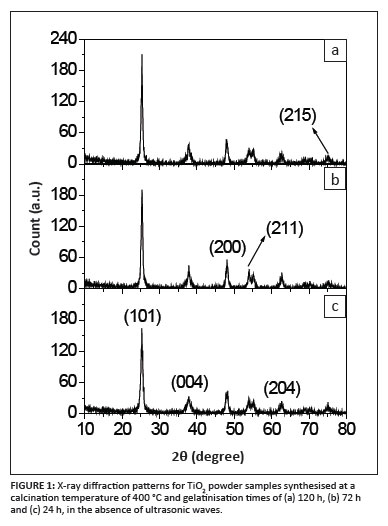
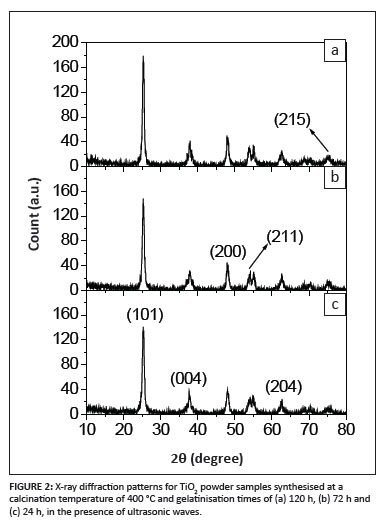
where S is the crystallite size, λ = 1.54056 Å (the wavelength of the X-ray radiation), K is a constant taken as 0.94, θ is the diffraction half angle and β is the line width at half maximum height.
Figure 3 and Table 1 show a comparison of the average diameter of synthesised crystallites with and without the use of ultrasonic waves. The crystallite dimensions evaluated from the line profile analysis of the XRD peaks indicated that all prepared samples were nanocrystalline in the anatase phase and that crystallites with a mean diameter of less than 15 nm were prepared in the presence of ultrasonic waves. By applying ultrasonic waves, the average diameter of the TiO2 nanoparticles was reduced by about 3 nm during each gelatinisation time of 24 h, 72 h and 120 h.
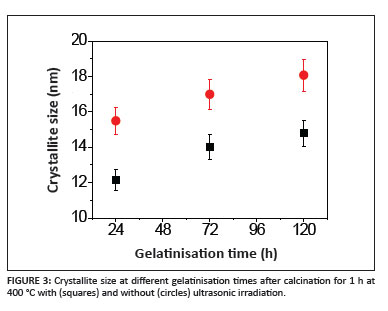

Both Figure 1 and Figure 2 show that, as gelatinisation time increases, the beam plates' diffraction peak of the anatase phase becomes sharper and the line width at half maximum height decreases. Therefore, by increasing the gelatinisation time, the size of the crystallites became larger. Figure 4 shows scanning electron microscope (SEM) images of TiO2 powder samples prepared using ultrasonic waves and different gelatinising times. With increased gelatinisation time, the boundaries between the nanometric grains became more specific and the shape of the particles became more spherical.
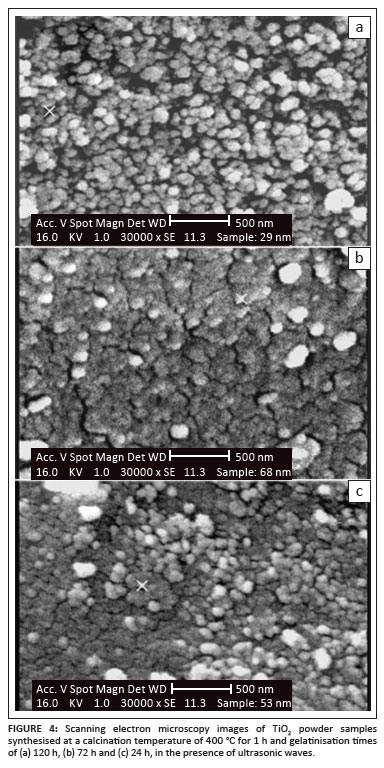
Figure 5 compares SEM images of TiO2 powder samples prepared using a gelatinisation time of 24 h, with and without ultrasonic waves. The images of the surface of the powder samples show clearly that using ultrasonic waves resulted in greater homogeneity in the average size of the particles and resulted in smaller particles. Transmission electron microscopy (TEM) also was used to investigate the particle size. Figure 6 shows a TEM image of nanoparticles synthesised using a gelatinisation time of 120 h, a calcination temperature of 400 ºC and ultrasonic waves. The nanoparticles produced had a diameter of 14 nm - 15 nm.
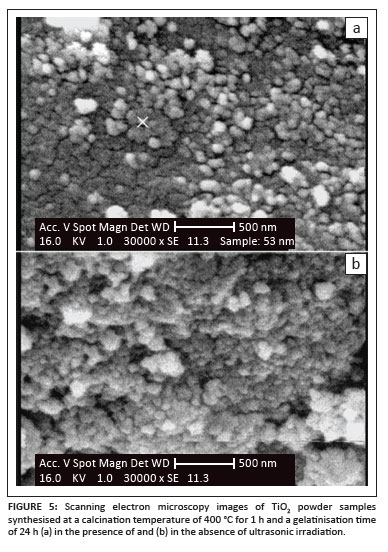
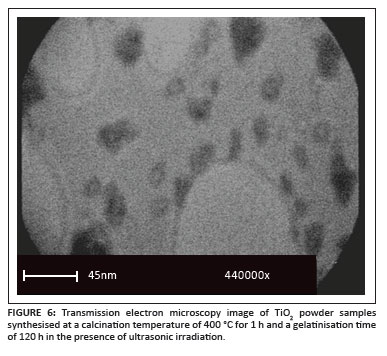
The above results show that if gelatinisation times are increased, the average size of TiO2 nanoparticles increases, irrespective of whether or not ultrasonic waves are applied. In addition, if ultrasonic waves are used, the average diameter of TiO2 nanoparticles decreases by about 3 nm. Thus, smaller and more controlled nanoparticles can be produced using ultrasonic waves.
Conclusion
We successfully prepared TiO2 nanoparticles using TiCl4 and ethanol as precursors by a sol-gel route, in the presence and absence of ultrasonic waves at room temperature. The use of ultrasonic waves led to smaller particle size, low-dimensional particle shape (spherical) and improved particle morphology. The fact that nanoparticles can be produced using ultrasonic waves, as reported in this paper, strongly supports the proposition that ultrasonic irradiation has great potential to control the formation of inorganic nanoparticles by influencing the organic reaction pathway.
References
1. Fujishima A, Honda K. Electrochemical photolysis of water at a semiconductor electrode. Nature. 1972;238:37-38. doi:10.1038/238037a0, PMid:12635268 [ Links ]
2. Trung T, Ha CS. One-component solution system to prepare nanometric anatase TiO2. Mater Sci Eng. 2004;C(24):19-22. [ Links ]
3. O'Regan B, Grätzel M. A low-cost, high-efficiency solar cell based on dye-sensitized colloidal TiO2 films. Nature. 1991;353:737-740. doi:10.1038/353737a0 [ Links ]
4. Adachi M, Murata Y, Takao J, Jiu J, Sakamoto M, Wang F. Highly efficient dye-sensitized solar cells with a titania thin-film electrode composed of a network structure of single-crystal-like TiO2 nanowires made by the "oriented attachment" mechanism. J Am Chem Soc. 2004;126:14943-14949. doi:10.1021/ja048068s, PMid:15535722 [ Links ]
5. Dürr M, Schmid A, Obermaier M, Rosselli S, Yasuda A, Nelles G. Low-temperature fabrication of dye-sensitized solar cells by transfer of composite porous layers. Nat Mater. 2005;4:607-611. doi:10.1038/nmat1433, PMid:16041379 [ Links ]
6. Wang W, Gu B, Liang L, Hamilton WA, Wesolowski DJ. Synthesis of rutile (a-TiO2) nanocrystals with controlled size and shape by low-temperature hydrolysis: Effects of solvent composition. J Phys Chem. 2004;B(108):14789-14792. [ Links ]
7. Skubal LR, Meshkov NK, Vogt MC. Detection and identification of gaseous organics using a TiO2 sensor. J Photochem Photobiol. 2002;A(148):103-108. [ Links ]
8. Meier KR, Gratzel M. Redox targeting of oligonucleotides anchored to nanocrystalline TiO2 films for DNA detection. ChemPhysChem. 2002;3:371-374. doi:10.1002/1439-7641(20020415)3:4<371::AID-CPHC371>3.0.CO;2-O [ Links ]
9. Thelakkat M, Schmitz C, Schmidt HW. Fully vapor-deposited thin-layer titanium dioxide solar cells. Adv Mater. 2002;14:577-581. doi:10.1002/1521-4095(20020418)14:8<577::AID-ADMA577>3.0.CO;2-S [ Links ]
10. Lim SH, Luo J, Zhong Z, Ji W, Lin J. Room-temperature hydrogen uptake by TiO2 nanotubes. Inorg Chem. 2005;44:4124-4126. doi:10.1021/ic0501723, PMid:15934734 [ Links ]
11. Kavan L, Grätzel M, Rathousky J, Zukal A. Nanocrystalline TiO2 (anatase) electrodes: Surface morphology, adsorption and electrochemical properties. J Electrochem Soc. 1996;143:394-400. doi:10.1149/1.1836455 [ Links ]
12. Khan SUM, Al-Shahry M, IngLer WB. Efficient photochemical water splitting by a chemically modified n-TiO2. Science. 2002;297:2243-2245. doi:10.1126/science.1075035, PMid:12351783 [ Links ]
13. Park JH, Kim S, Bard AJ. Novel carbon-doped TiO2 nanotube arrays with high aspect ratios for efficient solar water splitting. NanoLett. 2006;6:24-28. doi:10.1021/nl051807y, PMid:16402781 [ Links ]
14. Gonzalez RJ, Zallen R, Berger H. Infrared reflectivity and lattice fundamentals in anatase TiO2. Phys Rev. 1997;B(55):7014-7017. [ Links ]
15. Jiang X, Herricks T, Xia Y. Monodispersed spherical colloids of titania: Synthesis, characterization, and crystallization. Adv Mater. 2003;15:1205-1209. doi:10.1002/adma.200305105 [ Links ]
16. Wijnhoven G, Vos WL. Preparation of photonic crystals made of air spheres in titania. Science. 1998;281:802-804. doi:10.1126/science.281.5378.802 [ Links ]
17. Xiaobo C, Mao SS. Titanium dioxide nanomaterials: Synthesis, properties, modifications and application. Chem Rev. 2007;107:2891-2906. doi:10.1021/cr0500535, PMid:17590053 [ Links ]
18. Zhu Y, Zhang L, Gao C, Cao L. The synthesis of nanosized TiO2 powder using a sol-gel method TiCl4 as a precursor. J Math Sci. 2000;35:4049-4054. doi:10.1023/A:1004882120249 [ Links ]
19. Mahshid S, Askari M, Sasani Ghamsari M. Synthesis of TiO2 nanoparticles by hydrolysis and peptization of titanium isopropoxide solution. J Mater Process Technol. 2007;189:296-300. doi:10.1016/j.jmatprotec.2007.01.040 [ Links ]
20. Kaneko M, Okura I. Photocatalysis science and technology. Berlin/Heidelberg/New York: Kodansha/Springer Press, 2002; p. 57-260. [ Links ]
21. Tang Z, Zhang J, Cheng Z, Zhang Z. Synthesis of nanosized rutile TiO2 powder at low temperature. Mater Chem Phys. 2002;77:314-317. doi:10.1016/S0254-0584(02)00003-2 [ Links ]
22. Guo W, Lin Z, Wang X, Song G. Sonochemical synthesis of nanocrystalline TiO2 by hydrolysis of titanium alkoxides. Microelectron Eng. 2003;66:95-101. doi:10.1016/S0167-9317(03)00031-5 [ Links ]
23. Ramaswamy V, Jagtap NB, Vijayanand S, Bhange DS, Awati PS. Photocatalytic decomposition of methylene blue on nanocrystalline titania prepared by different methods. Mater Res Bull. 2008;43:1145-1152. doi:10.1016/j.materresbull.2007.06.003 [ Links ]
24. Morales BA, Novaro O. Effect of hydrolysis catalyst on the Ti deficiency and crystallite size of sol-gel TiO2 crystalline phases. J Mater Res. 1995;10:2788-2796. doi:10.1557/JMR.1995.2788 [ Links ]
25. Nam HJ, Amemiya T, Murabayashi M, Itoh K. Photocatalytic activity of sol-gel TiO2 thin films on various kinds of glass substrates: The effects of Na+ and primary particle size. J Phys Chem. 2004;B(108):8254-8259. [ Links ]
26. Yoldas BE. Hydrolysis of aluminium alkoxides and bayerite conversion. J Appl Chem Biotechnol. 1973;23:803-809. doi:10.1002/jctb.5020231103 [ Links ]
27. Pal M, Garcia Serrano J, Santiago P, Pal U. Size-controlled synthesis of spherical TiO2 nanoparticles: Morphology, crystallization, and phase transition. J Phys Chem. 2007;C(111):96-102. [ Links ]
28. Lee KM, Suryanarayanan V, Ho KC. The influence of surface morphology of TiO2 coating on the performance of dye-sensitized solar cells. Sol Energy Mater Sol Cells. 2006;90:2398-2404. doi:10.1016/j.solmat.2006.03.034 [ Links ]
29. Brinker J, Scherer GW. Sol-gel science. 1st ed. San Diego: Academic Press, 1990; p. 50-720. [ Links ]
30. Grant MH, Othmer K. Hydrogen sulfide in toxicology of the eye. Encycl Chem Technol. 1997;24:225-229. [ Links ]
31. Litter MI, Navio JA. Photocatalytic properties of iron-doped titania semiconductors. J Photochem Photobiol A Chem. 1994;84:171-181. [ Links ]
32. Palmisano L, Augugliaro V, Sclafani A, Schiavello M. Activity of chromium-ion-doped titania for the dinitrogen photoreduction to ammonia and for the phenol photodegradation. J Phys Chem. 1988;92:6710-6713. doi:10.1021/j100334a044 [ Links ]
33. Wang Y, Cheng H, Hao Y, Ma J, Li W, Cai S. Characterization and photo-electric behaviors of Fe(III) doped TiO2 nanoparticles. J Mater Sci. 1999;34:3721-3729. doi:10.1023/A:1004611724069 [ Links ]
34. Cheng H, Ma J, Zhao Z, Qi L. Hydrothermal preparation of uniform nanosize rutile and anatase particles. Chem Mater. 1995;7:663-671. doi:10.1021/cm00052a010 [ Links ]
35. Wang Y, Hao Y, Cheng H, et al. The photoelectrochemistry of transition metal-ion-doped TiO2 nanocrystalline electrode and higher solar cell conversion efficiency based on Zn+2-doped TiO2 electrode. J Mater Sci. 1999;34:2773-2779. doi:10.1023/A:1004658629133 [ Links ]
36. Akhtar MK, Xiong Y, Pratsinis SE. Vapor synthesis of titania powder by titanium tetrachloride oxidation. AIChE J. 1991;37:1561-1570. doi:10.1002/aic.690371013 [ Links ]
37. Ding Z, Hu X, Lu GQ, Yue PL, Greenfield PF. Novel silica gel supported TiO2 photocatalyst synthesised by CVD method. Langmuir. 2000;16:6216-6222. doi:10.1021/la000119l [ Links ]
38. Wang CC, Zhang Z, Ying JY. Photocatalytic decomposition of halogenated organics over nanocrystalline titania. Nanostruct Mater. 1997;9:583-586. doi:10.1016/S0965-9773(97)00130-X [ Links ]
39. Burns A, Li W, Baker C, Shah SI. Sol-gel synthesis and characterization of neodymium-ion doped nanostructured titania thin films. Mater Res Soc Sym. 2002;703:193-197. [ Links ]
40. Coville NJ, Tshavhungwe AM. Mesoporous ethanesilica materials with bimodal and trimodal pore-size distributions synthesised in the presence of cobalt ions. S Afr J Sci. 2010;106(7/8), Art. #213, 5 pages. doi: 10.4102/sajs.v106i7/8.213 [ Links ]
41. Wang Y, Chen S-G, Tang XH, et al. Mesoporous titanium dioxide: Sonochemical synthesis and application in dye-sensitized solar cells. J Mater Chem. 2001;11:521-526. doi:10.1039/b006070o [ Links ]
42. Huang W, Tang X, Wang Y, Koltypin Y, Gedanken A. Selective synthesis of anatase and rutile via ultrasound irradiation. Chem Commun. 2000;15:1415-1416. doi:10.1039/b003349i [ Links ]
43. Yu JC, Zhang LZ, Yu JG. Direct sonochemical preparation and characterization of highly active mesoporous TiO2 with a bicrystalline framework. Chem Mater. 2002;14:4647-4653. doi:10.1021/cm0203924 [ Links ]
44. Oh CW, Lee GD, Park SS, Ju CS, Hong SS. Synthesis of nanosized TiO2 particles via ultrasonic irradiation and their photocatalytic activity. React Kinet Catal Lett. 2005;85:261-268. doi:10.1007/s11144-005-0269-3 [ Links ]
45. Tian B, Chen F, Zhang J, Anpo M. Influences of acids and salts on the crystalline phase and morphology of TiO2 prepared under ultrasound irradiation. J Coll Interface Sci. 2006;303:142-148. doi:10.1016/j.jcis.2006.07.023, PMid:16890236 [ Links ]
46. Liu Y, Li Y, Wang Y, Xie L, Zheng J, Li X. Sonochemical synthesis and photocatalytic activity of meso- and macro-porous TiO(2) for oxidation of toluene. J Hazard Mater. 2008;150:153-157. doi:10.1016/j.jhazmat.2007.04.088, PMid:17560714 [ Links ]
47. Neppolian B, Wang Q, Jung H, Choi H. Ultrasonic-assisted sol-gel method of preparation of TiO2 nanoparticles: Characterization, properties and 4-chlorophenol removal application. Ultrason Sonochem. 2008;15:649-658. PMid:18024153 [ Links ]
48. Yang K, Zhu J, Huang S, Zhu X, Ma G. Sonochemical synthesis and microstructure investigation of rod-like nanocrystalline rutile titania. Mater Lett. 2003;57:4639-4642. doi:10.1016/S0167-577X(03)00376-8 [ Links ]
49. Latt KK, Kobayashi T. TiO2 nanosized powders controlling by ultrasound sol-gel reaction. Ultrason Sonochem. 2008;15:484-491. doi:10.1016/j. ultsonch.2007.08.001, PMid:17904404 [ Links ]
50. Mahmoud MA, Poncheri A, Badr Y, Abd El Wahed MG. Photocatalytic degradation of methyl red dye. S Afr J Sci. 2009;105:299-303. [ Links ]
 Correspondence to:
Correspondence to:
Hossain Milani Moghaddam
Postal address:
Physics Department, Mazandaran University, Pasdaran Street,
PO Box 416
Babolsar, Mazandaran, Iran
email: milani@umz.ac.ir
Received: 04 Aug. 2010
Accepted: 08 Dec. 2010
Published: 14 Mar. 2011
© 2011. The Authors. Licensee: OpenJournals Publishing. This work is licensed under the Creative Commons Attribution License.














